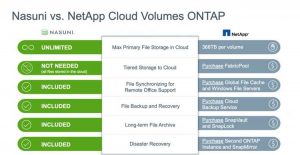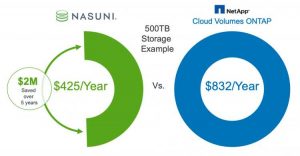From Nasuni, 3 Considerations When Navigating NetApp Confusing Public Cloud File Storage Offerings
What to choose to get cloud file storage that scales without limits, costs 3-5x less, and simple to administer?
This is a Press Release edited by StorageNewsletter.com on September 17, 2021 at 1:31 pm This blog was authored on September, 2021 by Tom Rose, chief marketing officer, Nasuni Corporation
This blog was authored on September, 2021 by Tom Rose, chief marketing officer, Nasuni Corporation
3 Considerations When Navigating NetApp’s Confusing Public Cloud File Storage Offerings
Does this sound familiar ? You and your IT leadership are frustrated with the cost and complexity of your existing file infrastructure, and you know the advantages that moving to the cloud can offer.
So, you’re tasked with making the switch from on-premises NAS and file servers to cloud file storage. You start looking at the alternatives, and you quickly see a familiar storage vendor, NetApp, offering a portfolio of ‘public cloud’ solutions. The known brand is appealing, but you’re confused by the myriad of product names and choices:
-
There’s Cloud Volumes Service, which is NetApp hardware lifted and shifted to an AWS or Google Cloud data center, and offered as a managed service.
-
There’s also Cloud Volumes ONTAP, which is a virtual instance of NetApp software that runs in cloud compute on top of cloud block storage, and offered as a managed service.
-
There’s even Azure NetApp Files, which is the Cloud Volumes Service for Azure, rebranded and offered only by Microsoft.
-
Then there’s a bunch of add-ons needed for all of these choices, such as SnapMirror for replication and snapshot-based data protection, FabricPool tiering to object storage to overcome capacity limitations and reduce costs, Global File Cache for on-prem caching and file synchronization, and Cloud Backup Service for long-term data protection.
You quickly realize that this is just as complex as your on-prem file storage, has the same scaling constraints – and is a lot more expensive. Which is not what you expected when you thought moving to the cloud would be simpler, infinitely scalable, and less costly. What happened?
It’s because these new solutions are essentially ‘cloud-washed’ upgrades of NetApp’s old products. They might be a bit better than what the company was pushing a decade ago, but under the covers it’s still the same old technology.
The difference between Nasuni and NetApp is the difference between a platform that was born in the cloud and one that has been ported to the cloud. It’s the difference between a revolutionary new technology and a legacy technology with a new business and marketing plan.
Let’s revisit the assumptions you had about the advantages that the cloud can deliver: Scale, Savings, and Simplicity.
Scale – Why perpetuate hardware limitations?
NetApp’s cloud offerings remain anchored to their old way of selling storage and data protection. Limitations were central to the NetApp business model because, whenever you outgrew something, you had to buy more of their hardware. The company’s fortunes were built on selling boxes, and even though we are now in the cloud era, NetApp has held on to that old way of managing scale. They’ve had to impose limits on the unlimited cloud because their underlying technology hasn’t changed. Volumes are capped at 100TB, snapshots (recovery points) are limited to 255, files often can’t be larger than 16TB, total system capacity is limited to 368TB—the list goes on.
Click to enlarge
Since Nasuni was designed and built for the cloud, and we do not need to move hardware to profit, we don’t have NetApp’s constraints. Our UniFS file system resides and scales in limitless cloud object storage, and our platform is completely software-defined, so your file storage can grow indefinitely without filling up on-prem or cloud-hosted hardware. You get unlimited volumes (simpler drive mappings). Unlimited, continuous snapshots (i.e. unlimited recovery points and faster ransomware recovery). Unlimited capacity (no more silos). NetApp Cloud Volumes ONTAP vs. Nasuni – Limitations has more comparisons.
One of our mid-sized customers – a former NetApp shop – now has 750 million files and over a billion versions stored in Nasuni. Yet, they’re still saving money – which brings me to the next point.
Savings – Why pay 3-5x more?
The NetApp approach is to lift and shift the primary storage you’ve relied on in the past to the cloud, then add on costs for snapshots, cloud tiering, backup, DR, and edge caching. And, if you do need on-prem file access, you’ll need to pay for, deploy, and manage a whole pile of Windows servers to orchestrate edge caching and file synchronization. These costs add up quickly, as explained in NetApp Cloud Volumes ONTAP vs. Nasuni – Cost Comparison. Not only do your hard costs increase, but the whole environment becomes increasingly difficult to manage, which saps IT resources and increases operational costs.
Nasuni only requires two things – your Nasuni subscription and your choice of AWS, Azure, or Google Cloud object storage. Our use of low-cost, durable cloud object storage as the authoritative source of all file data and metadata means that our costs are much lower from the start. We cache copies of frequently-used files to edge locations using lightweight VMs, so we don’t need to do any stopgap tiering. Our built-in, no-limits snapshot technology, The company’s Continuous File Versioning, means you don’t have to pay for expensive snapshot storage or file backup, or saddle highly-trained IT professionals with snapshot pruning or backup administration tasks. We don’t need secondary instances for DR, because the cloud automatically makes multiple copies of your data, and our edge VMs can be rehydrated in minutes from object storage. Plus, the Nasuni Orchestration Center (NOC) – an infinitely-scalable, multi-region cloud service included as part of your Nasuni subscription – handles all control functions, such as volume management, snapshot version alignment, global file lock, management message queues, and more. No Windows servers for you to purchase, deploy, and manage.
… which rolls into my final point:
Simplicity – Why make IT’s job harder?
Click through the websites of NetApp and the other traditional storage providers, and you’re bound to be confused by all their cloud offerings. Now, imagine that you do deploy their suggested mix of products and add-ons, and you now have to ask your IT operations team to manage them. You’re going to end up with a patchwork of tools and admin consoles to integrate your cloud and on-prem operations.
With Nasuni, all of your file storage operations are consolidated into one cloud-native architecture. Our customers laud the ‘set it and forget it’ nature of our platform. When something does need to be configured or adjusted, it can be done from anywhere, at any time, through our proverbial ‘single pane of glass’: the Nasuni Management Console.
Keanu Reeves/Matrix reference summing up storage blog?
Decades ago, enterprises started choosing NetApp because they designed a next-gen file system from scratch for clusters of on-premises hardware. Today, those same enterprises are choosing Nasuni because we designed a next-gen file system from scratch for unlimited cloud object storage, and a cloud control path that orchestrates edge caching, multi-site file synchronization, version control, and infinite snapshots.
Which should you choose if you want cloud file storage that scales without limits, costs 3-5X less, and is simple to administer?
As Neo said at the end of The Matrix: “I’m going to show them a world without you. A world without rules and controls, without borders or boundaries. A world where anything is possible. Where we go from there is a choice I leave to you.”
Resources:
Comparison of the administration differences between NetApp and Nasuni
Is cost your biggest concern about moving file storage to the cloud? Ask for our NetApp vs. Nasuni cost comparison
Nasuni vs. NetApp for Next-Gen Cloud File Storage Infrastructure (registration required)














 Subscribe to our free daily newsletter
Subscribe to our free daily newsletter
